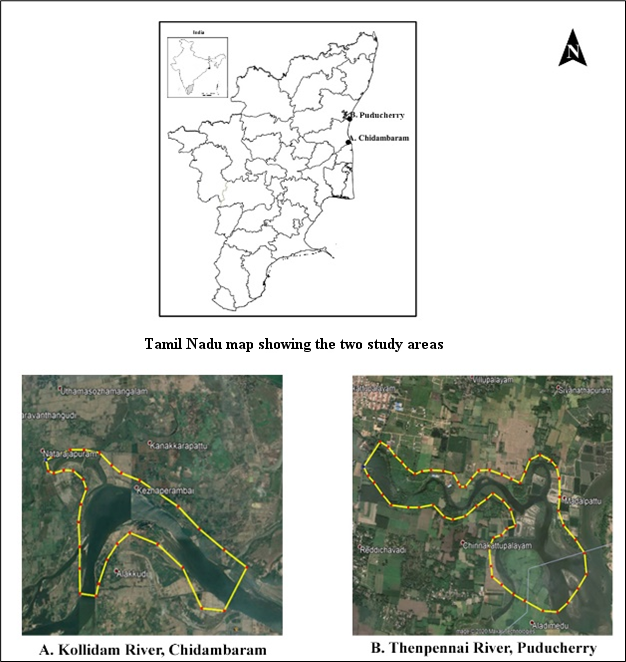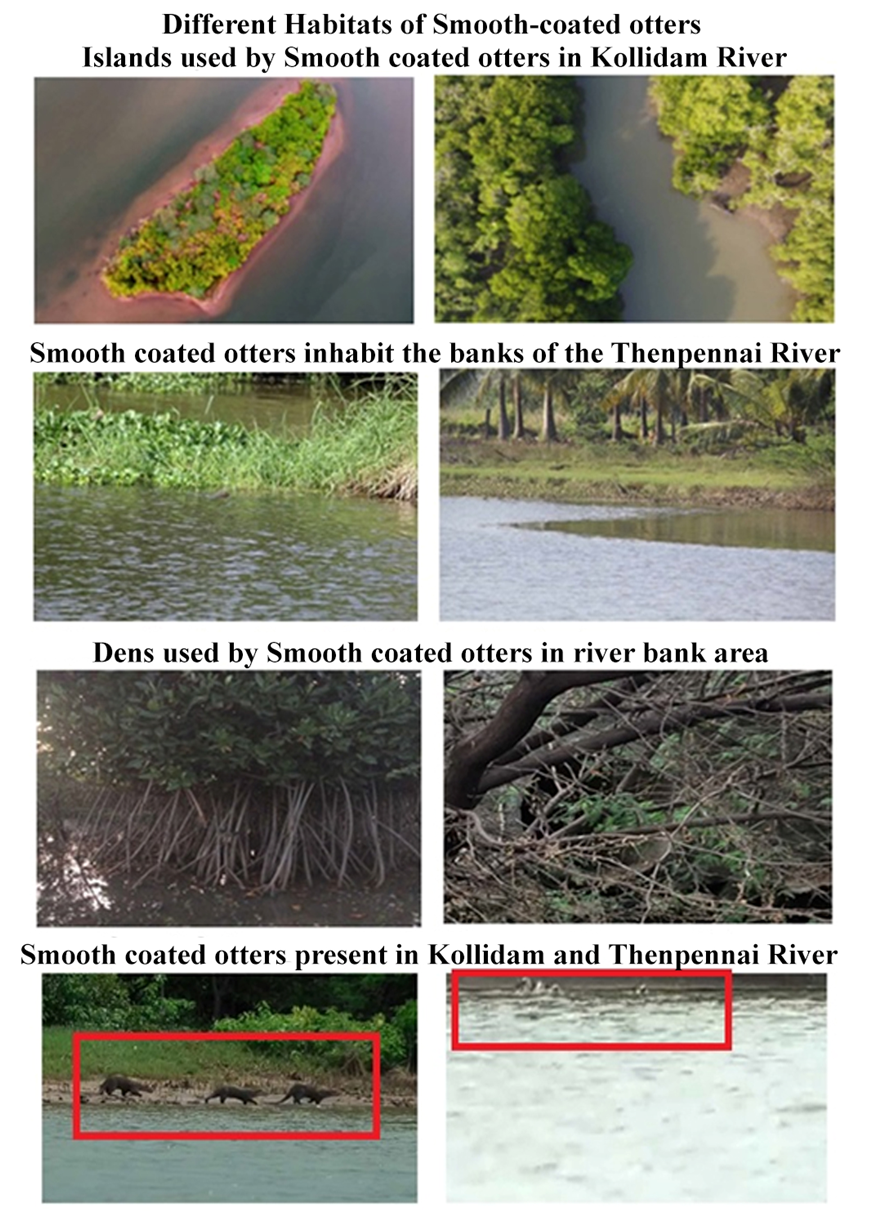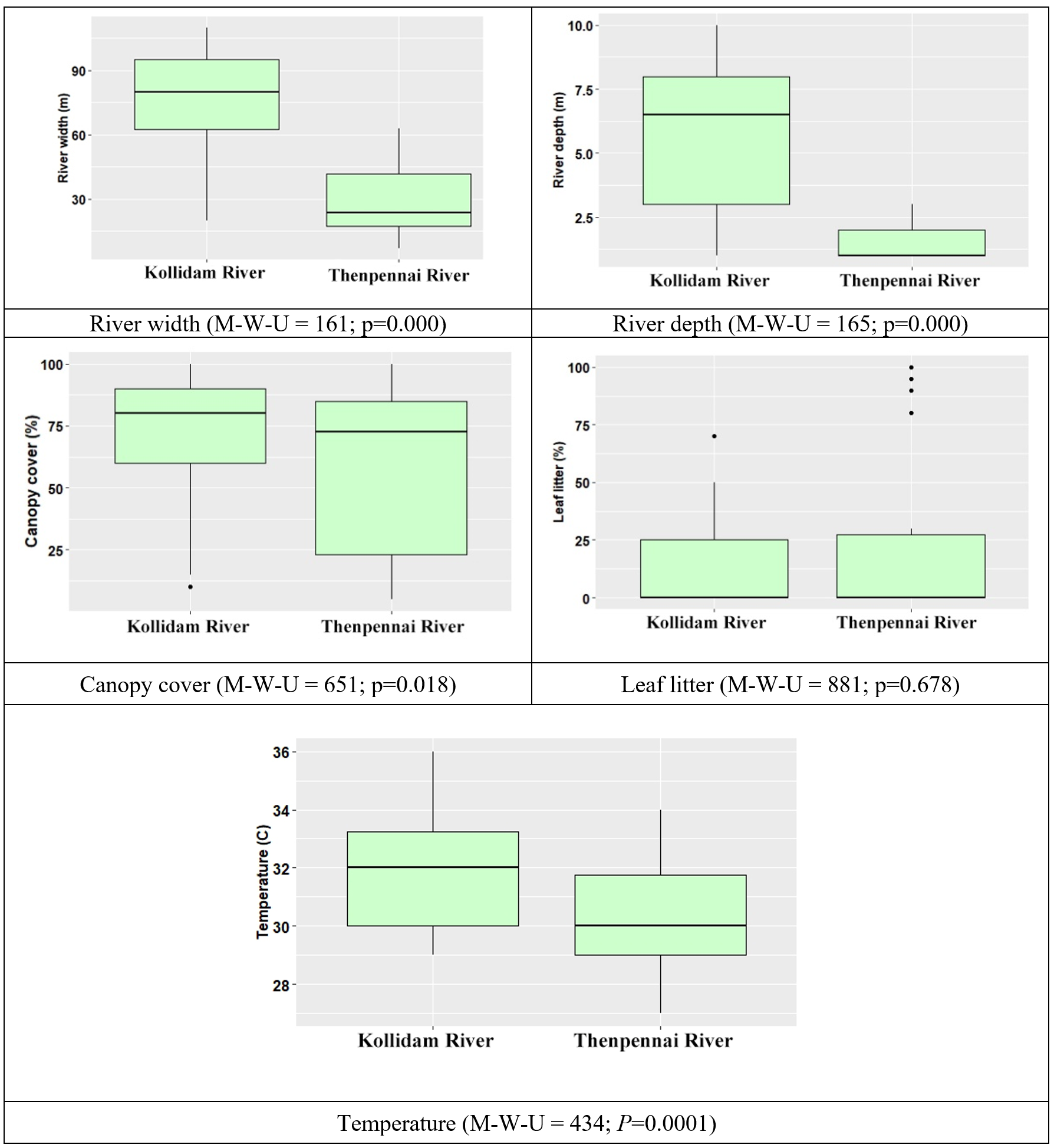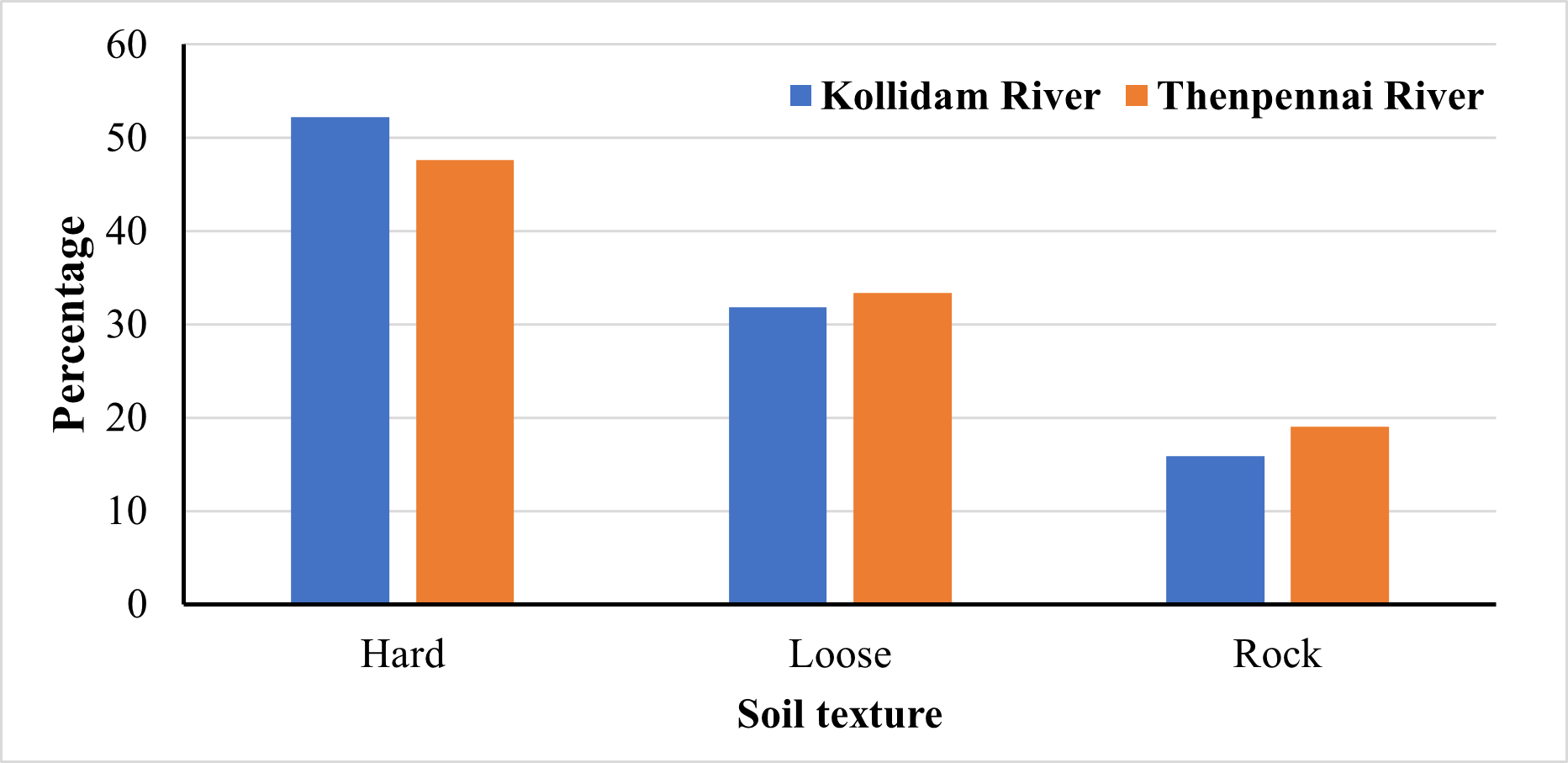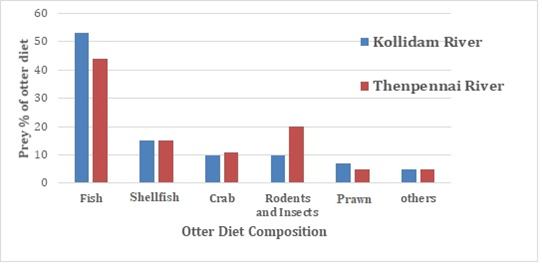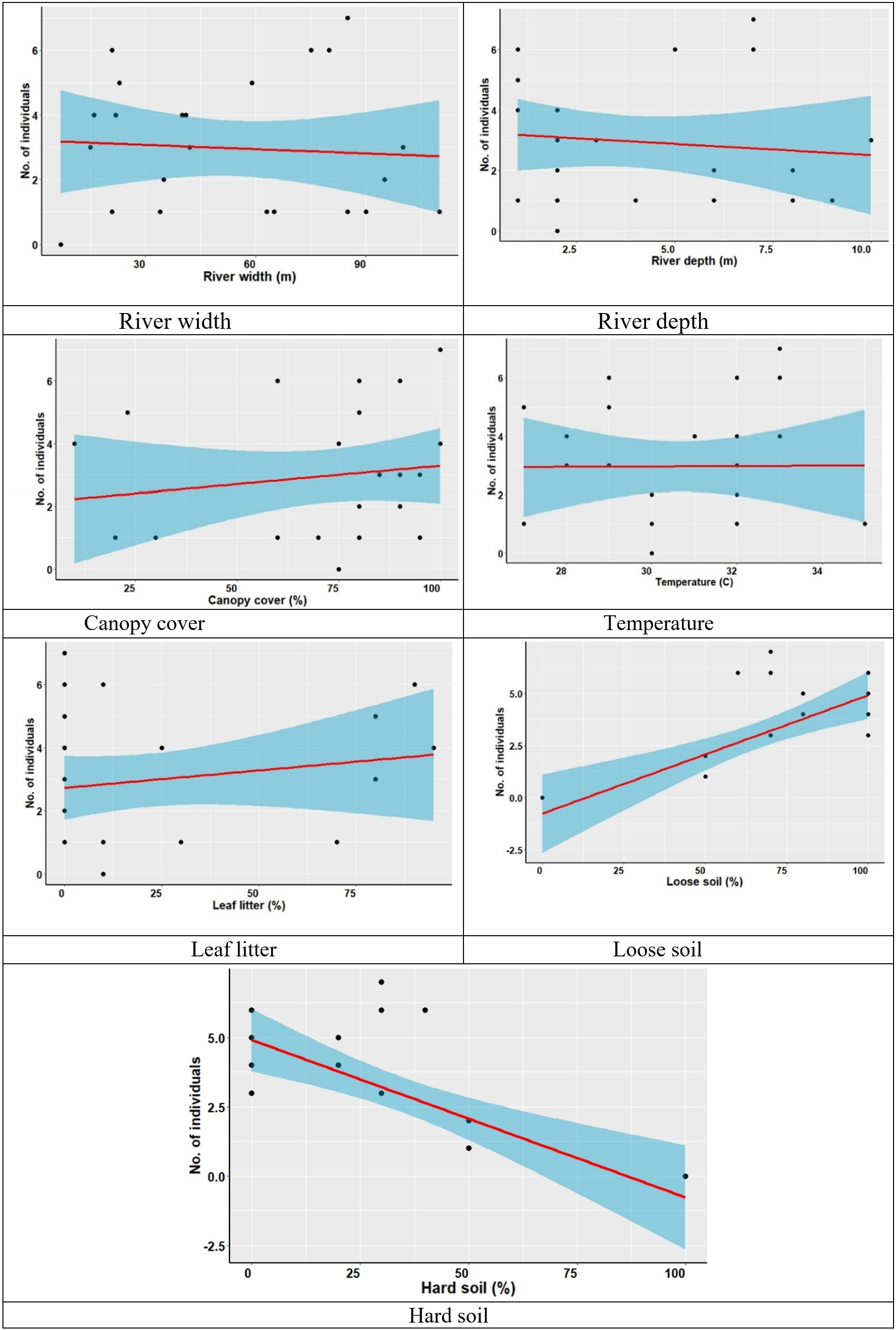IUCN/SSC Otter Specialist Group Bulletin

©IUCN/SCC Otter Specialist Group
Volume 40 Issue 1 (January 2023)
Citation: Jayasurya, R., Moorthi, M., Sathishkumar, S., and Srimathi, R. (2023). Distribution, Habitat Selection and Diet of Smooth-Coated Otters (Lutrogale perspicillata) in the Kollidam and Thenpennai Rivers in South India. IUCN Otter Spec. Group Bull. 40 (1): 3 - 15
Distribution, Habitat Selection and Diet of Smooth-Coated Otters (Lutrogale perspicillata) in the Kollidam and Thenpennai Rivers in South India
Ravikumar Jayasurya, Mahaly Moorthi,*,Selvarasu Sathishkumar1, and Ravichandran Srimathi1
1G & Research Department of Zoology and Wildlife Biology, A.V.C. College (Autonomous), Mayiladuthurai – 609305, Affiliated to Annamalai University, Chidambaram, Tamil Nadu, India
*Corresponding Author Email: moovim24@gmail.com
Received 22nd June 2022, accepted 14th September 2022
Abstract: We document the presence of the Smooth-coated otter (Lutrogale perspicillata) in the Kollidam River in Tamil Nadu and Thenpennai River in Puducherry, South India. Prior to this, there was no information about this animal in these Kollidam and Thenpennai Rivers, although the species is known to inhabit Tamil Nadu and Puducherry, where it is often found in mangrove ecosystems and estuaries. The Smooth-coated otter is currently listed as Vulnerable on the IUCN Red List. A total of 22 km of river bank were surveyed in 2019 and 2020, 15 km along Kollidam River and 7 km along the Thenpennai River. A total of twenty-seven individual otters were observed in the study areas, 15 along the Kollidam River and 12 along the Thenpennai River. Otter diet consisted of 53% and 46% fish, respectively, and included small percentages of insects, rodents, crabs, and prawns. Eight parameters, including leaf litter, loose soil and canopy cover were positively correlated with otter presence, while river width and depth and hard soil were negatively correlated. Smooth-coated otters appear to be threatened by poaching and habitat degradation in the area.
Keywords: Smooth-coated otter, South India, habitat, diet
INTRODUCTION
We conducted a survey that confirms the presence of Smooth-coated otters in the Kollidam and Thenpennai Rivers in South India. Several studies have previously recorded Smooth-coated otter presence in Tamil Nadu (Joshi et al., 2016; Kalaimani et al., 2021; Arivoli and Narasimmarajan, 2021; Narasimmarajan et al., 2021), where it is often found in the mangrove ecosystems and estuaries. Pollution and degradation of aquatic habitats is rampant in many urban areas of India. The concretization of river banks and modifications to coastal environments often drastically change riparian habitats that are critical for otters, including den and grooming sites (de Silva et al., 2015). Human pressure in South India has resulted in water pollution, habitat fragmentation and shrinking water bodies (Raj, 1941; Ruiz-Olmo and Consalbez, 1997; Gupta et al., 2020; Narasimmarajan et al., 2021). This study was intiated to document distribution, habitat, and diet of the species as a basis for conservation in the Kollidam and Tenpennai Rivers in Tamil Nadu and Puducherry.
MATERIALS AND METHODS
Study area
The survey was conducted along stretches of the Kollidam and Thenpennai Rivers in Tamil Nadu and Puducherry (Fig. 1). The Kollidam River is a tributary of the Kauveri River which separates from the main channel at the delta and flows independently into the Bay of Bengal. This area has a healthy mangrove forest, good water quality and food availability, and sparse human settlement. The Thenpennai River flows for a distance 320 km in the state of Tamil Nadu, starting in Dharmapuri District and ending in Cuddalore District, where it also flows into the Bay of Bengal, north of the Kauveri Delta. The region around the Thenpennai River is heavily used for agricultural and industrial activities.
This study surveyed 22 km of riverbank, their tributaries and other adjoining water bodies, 15 km in Kollidam River and 7 km in Thenpennai River (Fig. 2). Both rivers have a rich invertebrate fauna and fish community in estuarine and wetland in their lower reaches. Avicennia marina, Acanthus illicifolius, and Rhizophora mucronata are common plants along the Kollidam River, and Eichhornia crassipes, cocos nucifera along the Thenpennai River, together with other herbs and shrubs. The climate of the Kollidam is characterized by hot, humid summers with highs of around 35-45 ºC and mild, pleasant winters with an average high temperatures around 28 ºC. The climate of the Thenpennai River is classified by hot, humid summers with highs of around 40-46 ºC and warm, pleasant winters with average high temperatures of 25-29 ºC.
Data collection
Survey methodology and habitat and den analysis
Smooth-coated otter population surveys were conducted in 2019 and 2020, by direct and indirect sighting methods following Hussain and Choudhury (1997). Direct observation of otters was recorded using a 10’×50” binocular and zoom telescope. Canon EOS-1300D cameras (24.1MP) were used for image capture. A range finder was used to find the distance from the observer to the animals. The presence of otters was also determined through indirect signs, such as scat, tracks, and grooming sites.
Field surveys were conducted by foot along both river banks and other waterbody banks (Brzeziński et al, 1993; Anoop and Hussain, 2004). Islands in the river were investigated by boat and the number of individuals and their movement on the islands was noted. The river stretches were divided into 500m transects, and 5m × 5m plots were systematically laid every 100m on both river banks and on the islands. Indirect signs such as scat, tracks, dens, and grooming sites of otters were recorded in the plots. Data was collected on habitat parameters such as river width (m), river depth (m), canopy cover (%), temperature (ºC), leaf litter (%) and type of substrate (hard sand, loose sand, or rock) in each section (Hussain et al., 2011; Nawab and Hussain, 2012; Khan et al., 2014).
Collection and analysis of scat samples
Scat was collected from the study area, stored in zip-lock bags, and soaked in detergent then thoroughly washed in tap water. The washed material was drained with 1mm mesh and the samples were stored separately with date and location and kept for analysis (Anoop, 2001). Diet composition was determined using a methodology of Goszczyński (1974) and Jędrzejewska et al. (2001). The undigested prey body parts were recovered for species analysis (Conroy and Chanin 2000). To help identify prey composition, fish scales, crabs, prawns, and other components of the scat were removed and studied using a compound microscope (Wise et al., 1981).
Data from both study sites were combined. The data were statistically analyzed using SPSS and ‘R’ Programme. First, the compiled data were checked for homogeneity of variance and normality prior to detailed analysis. Since the data were not normal, non-parametric tests were used. Mann-Whitney U test was used for two variables variation and Kruskal-Wallis test was used for analysis of 3 variables. Box-whisker plots were used to represent the results of the Mann-Whitney U test. The data were pooled together for habitat selection. A Principal Component Analysis (PCA) test was used to find the factors influencing habitat use. Parameters with a factor loading >=0.3 were considered significantly important in contributing to a particular factor or principal component. The percentage of diet component were calculated by using methodology of Wise et al. (1981) and Fonseca et al. (2008). The percentage of samples in each category relative to the overall sample count was used to express the results, as follows, where:
FO(%) = (100 n) / N
FO (%): Relative frequency of occurrence of a prey category
n: Number of samples with occurrence of a prey category
N: Total number of fecal samples analyzed
RESULTS
Otter distribution
Twenty-seven individuals were observed throughout the two study areas. Fifteen individuals were found in various sites along the Kollidam River. At this site, otters were most abundant in mangroves at 47%, followed by 33% on river islands, and 20% along riverbanks. Twelve individuals were found in various sites along the Thenpennai River, 58% on river islands and 42% along river banks (Fig. 2, 3).
Habitat characteristics of the study areas
Habitat parameters were significantly different between the Kollidam and Thenpennai Rivers with the exception of leaf litter. The Kollidam River was significantly wider than the Thenpennai (M-W-U = 161; P<0.001). The Kollidam River was significantly deeper than the Thenpennai (M-W-U -165.0, P<0.001). The Kollidam had a significantly higher canopy cover than the Thenpennai (M-W-U = 651.5, P=0.018). The Kollidam was significantly warmer than the Thenpennai (M-W-U - 434.0, P<0.001) (Fig. 4). Hard soil substrate had the highest percentage in the Kollidam (52%) and Thenpennai (48%), followed by loose soil and rock, (Table 1, Figs. 4, 5).
Dens
Twelve dens, both active and inactive, were identifed in the study areas, mainly in mangrove, sand, and cave-like sites. On the Kollidam River, the otters primarily used riverbanks and mangrove roots for temporary dens, and primarily riverbank and tree roots along the Thenpennai River. The number of den entrances varied from two to four, and den depth ranged from 1m to 3m, with an average width of about 1m. Average distance from water was <1m (Fig. 6).
Diet Composition
A total of 66 scat samples were collected from the two study sites. Fish were the main prey category in the diet of otters in Kollidam and Tenpennai Rivers at 53% and 46% respectively. Other prey included shellfish, 15%, and crabs, 11%, with a rare representation of rodents (Fig. 7). No amphibian remains were recorded.
Factors affecting on habitat selection
Of eight habitat parameters, leaf litter, loose soil and canopy cover showed a positive relationship with otter presence. In contrast, river width, river depth and hard soil showed a negative relationship. The greater representation (Cos2) of the variables >0.30 are in boldfaced in Table 2. In this analysis, the first three principal components explain 68.37% of the variation, an acceptably large percentage. These principal components from the data were considered for the PCA interpretation. The first principal component is strongly correlated with four variables and the total variance is 41.21%. In the first principal component increased with increasing loose soil (0.47), canopy cover (0.31) and decreased with hard soil (-0.38), river width (-0.56) and river depth (-0.46). The second principal component increased with only one of the values –temperature - (-0.31) are decreased with 32.1% of variance (Table 2, Fig. 8).
Discussion
This study documented otter presence in the Kollidam River and Thenpennai River for the first time. Several studies have documented the observation and occurrence of otter species in other areas, according to otter surveillance records in Tamil Nadu and Puducherry (Cauvery Wildlife Sanctuary, Tamil Nadu - Shenoy et. al. 2006; Sankaraparani River, Puducherry - Raman et al. 2019; Moyar valley, Western Ghats - Narasimmarajan et al., 2021; Kilnathur Lake, Arunagiri Park pond, Thiruvannamalai - Kalaimani et al., 2021; Vaduvoor Bird Sanctuary, Thiruvarur - Arivoli and Narasimmarajan, 2021). Arivoli and Narasimmarajan 2021 recorded 6 otters at Vaduvoor Birds Sanctuary. A Smooth-coated otter site was recently recorded at Kilnathur Lake, Arunagiri Park pond, Thiruvannamalai (Kalaimani et al., 2021). The habitat preferences of otters of the present study is similar to those previously reported. Shenoy et al. (2006) reported the same of loose soil as a positive, and hard soil as a negative, factor for otter presence. River depth and width had a negative relationship with otter presence, as reported by Raha and Hussian (2016). Otter dens were mainly found in mangroves, in rock crevices, and in sandy environments, similar to results reported by Hussain and Choudhury (1997). Fish were the major diet component of otters in these two rivers, with insects and rodents a small percent of total diet. Fifty-three percent of diet, as analyzed from scat samples, consisted of fish scale and bone. Hussain (1993) and Anoop (2001) also documented fish as the main food for Smooth-coated otters. The association between habitat selection and prey abundance are the main influences to otter occurrence.
CONCLUSION
Otters thrive in South Indian environments that are conducive to their presence: mangrove vegetation, shallow water, rocks, loose sand and riverine banks with good riparian cover. But polluted waters, infrastructure construction and human settlements have created fragmmented habitat and reduced food for otters. Poaching and general degradation of natural habitats threaten otter populations in South India. There is a potential for the further declines of Smooth-coated otter populations in the South Indian states of Tamil Nadu and Puducherry. We recommend a more comprehensive survey of these two river basin and public awareness programs to better conserve Smooth-coated otters, an important component of freshwater ecosystems in the region.
Acknowledgements: We acknowledge Mr. Ram, IBF Organization, Puducherry and Mr. Kumaran Geopaddler, Mangrove Bay Eco camp, Sirkazhi for the constant help during the fieldwork.
REFERENCES
Anoop, K.R. (2001). Factors affecting habitat selection and feeding habits of Smooth–coated Otter Lutra perspicillata in Periyar Tiger Reserve, Kerala. Unpublished M. Sc. thesis. Wildlife Insitute of India, Dehra Dun, India. https://doi.org/10.1017/S0952836904005461
Anoop. K.R., Hussain, S.A. (2004). Factors affecting habitat selection by smooth-coated otters (Lutra perspicillata) in Kerala, India. Journal of Zoology 263: 417-423. https://doi.org/10.1017/S0952836904005461
Arivoli, K., Narasimmarajan, K. (2021). First Record of an Elusive Predator: The Smooth-coated Otter (Lutrogale perspicillata) from Vaduvoor Bird Sanctuary, Thiruvarur District, Tamil Nadu, Southern India. IUCN Otter Specialist Group Bulletin, 38: 79-84. https://www.iucnosgbull.org/Volume38/Arivoli_Narasimmarajan_2021.pdf
Brzeziński, M., Jędrzejewska, W., Jędrzejewska, B. (1993). Diet of otters (Lutra lutra) inhabiting small rivers in the Bialowieza National Park, eastern Poland. Journal of Zoology 230: 495-501. https://doi.org/10.1111/j.1469-7998.1993.tb02701.x
Conroy, J.W., Chanin, P.R. (2000). The status of the Eurasian otter (Lutra lutra) in Europe. A Review. Journal of the International Otter Survival Fund 1:7-28.
de Silva, P., Khan, W.A., Kanchanasaka, B., Reza Lubis, I., Feeroz, M.M., Al-Sheikhly, O.F. (2015). Lutrogale perspicillata. The IUCN Red List of Threatened Species 2015.
No longer available. Superceded by
Khoo, M., Basak, S., Sivasothi, N., de Silva, P.K., and Reza Lubis, I. (2021). Lutrogale perspicillata. The IUCN Red List of Threatened Species 2021: e.T12427A164579961. https://dx.doi.org/10.2305/IUCN.UK.2021-3.RLTS.T12427A164579961.en.
Fonseca, V.C., Rheingantz, M.L., Fernandez, F.A., dos Santos (2008). A Comparison of Two Different Methods for Estimating the Diet of the Neotropical Otter, Lontra Longicaudis, with the Proposal of a New Index for Dietary Studies. IUCN Otter Specialist Group Bulletin, 25 (1): 6 – 12. https://www.iucnosgbull.org/Volume25/Fonseca_et_al_2008.html
Goszczyński, J. (1974). Studies on the food of foxes. Acta Theriologica, 19: 1-18. https://rcin.org.pl/Content/10198/PDF/BI002_2613_Cz-40-2_Acta-T19-nr1-1-18_o.pdf
Gupta, N., Tiwari, V., Everard, M., Savage, M., Hussain, S.A., Chadwick, M.A., Johnson, J.A.,
(2020). Assessing the distribution pattern of otters in four rivers of the Indian Himalayan biodiversity hotspot. Aquatic Conservation. Marine and Freshwater Ecosystems 30: 601-610.
https://agris.fao.org/agris-search/search.do?recordID=AV2012074590
Hussain, S.A. (1993). Aspects of the ecology of smooth-coated Otters Lutra perspicillata in National Chambal Sanctuary. Unpublished Ph.D Thesis. Center for Wildlife and Ornithology. Aligarh Muslim University. Aligarh, India. http://hdl.handle.net/10603/58828
Hussain, S.A., Choudhury, B.C. (1997). Status and distribution of Smooth-coated Otter Lutra perspicillata in National Chambal Sanctuary. Biological Conservation, 80: 199-206. https://doi.org/10.1016/S0006-3207(96)00033-X
Hussain, S.A., Gupta, S.K., de SILVA, P.K. (2011). Biology and ecology of Asian small-clawed otter Aonyx cinereus (Illiger, 115): a review. IUCN Otter Specialist Group Bulletin, 28: 63-75. https://www.iucnosgbull.org/Volume28/Hussain_et_al_2011.html
Jędrzejewska, B., Sidorovich, V.E., Pikulik, M.M. Jędrzejewska, W. (2001). Feeding habits of the otter and the American mink in Białowieża Primeval Forest (Poland) compared to other Eurasian populations. Ecography 24: 165-180. https://www.jstor.org/stable/3683692
Joshi, A.S., Tumsare, V.M., Nagar, A.K., Mishra, A.K., Pariwakam, M.P. (2016). Photographic records of Eurasian Otter Lutra lutra from the central Indian landscape. IUCN Otter Specialist Group Bulletin, 33: 73-78. https://www.iucnosgbull.org/Volume33/Joshi_et_al_2016.html
Kalaimani, A., Nagarajan, R., Kumar, S., Salman, M. (2021). New site records of Smooth- coated Otter in Tiruvannamalai, Tamil Nadu. Small Mammal Mail 432, In: Zoo’s Print 36: 05–06. https://www.zoosprint.zooreach.org/index.php/zp/article/download/7172/6504
Khan, M.S., Dimri, N.K., Nawab, A., Ilyas, O., Gautam, P. (2014). Habitat use pattern and conservation status of smooth–coated otters Lutrogale perspicillata in the Upper Ganges Basin, India. Animal Biodiversity and Conservation 37: 69-76. https://doaj.org/article/b3d55fef59234beebd4a503cdfcf97c6
Narasimmarajan, K., Hayward, M.W., Mathai, M.T. (2021). Assessing the Occurrence and Resource Use Pattern of Smooth-coated Otters Lutrogale perspicillata Geoffroy (Carnivora, Mustelidae) in the Moyar River of the Western Ghats Biodiversity Hotspot. IUCN Otter Specialist Group Bulletin, 38(1), 45-58. https://www.iucnosgbull.org/Volume38/Narasimmarajan_et_al_2021.html
Nawab, A., Belwal, V.K. (2020). Assessing the distribution pattern of otters in four rivers of the Indian Himalayan biodiversity hotspot. Aquatic Conservation: Marine and Freshwater Ecosystems 30: 601-610. http://dx.doi.org/10.1002/aqc.3284
Nawab, A., Hussain, S.A. (2012). Factors affecting the occurrence of smooth‐coated otter in aquatic systems of the Upper Gangetic Plains, India. Aquatic conservation: Marine and freshwater ecosystems, 22(5): 616-625.
Raha, A., Hussain, S.A. (2016). Factors affecting habitat selection by three sympatric otter species in the southern Western Ghats, India. Acta Ecologica Sinica, 36: 45-49. https://daneshyari.com/article/preview/4379764.pdf
Raj, B.S. (1941). October. Dams and fisheries; mettur and its lessons for India. In Proceedings of the Indian Academy of Sciences-Section B 14,(4): 341-358). https://www.ias.ac.in/public/Volumes/secb/014/04/0341-0358.pdf
Raman, K., Sivangnanaboopathidossvimal, Sakthivel Kishorekumar, Bawa M. Krishnakuamr and Kanagaraj M. Selvan (2019) Occurrence of Smooth-Coated Otter Lutrogale perspicillata in Sankaraparani River, Puducherry, India. IUCN Otter Spec. Group Bull. 36(1): 28 – 33 https://www.iucnosgbull.org/Volume36/Raman_et_al_2019%20.html
Ruiz-Olmo, J., Gosálbez, J. (1997). Observations on the sprainting behaviour of the otter Lutra lutra in the NE Spain. Acta Theriologica, 42: 259-270. https://rcin.org.pl/dlibra/show-content/publication/edition/12693?id=12693
Shenoy, K., Varma, S., Prasad, K.D. (2006). Factors determining habitat choice of the smooth-coated otter, Lutra perspicillata in a South Indian River system. Current Science, 91:637-643. http://eprints.iisc.ac.in/8831/1/Factors_determining_habitat_choice_of_the.pdf
Wise, M.H., Linn, I.J., Kennedy, C.R. (1981) A comparison of the feeding biology of mink Mustela vison and otter Lutra lutra. Journal of Zoology London, 195: 181–213. https://doi.org/10.1111/j.1469-7998.1981.tb03458.x
Multimedia Files
https://www.youtube.com/watch?v=8-QPaAsOpi8&ab_channel=Bio-scienceandWildConservation-Dr.M.Moorthi
(video no longer available 02/03/23)
Résumé: Distribution, Selection de l’Habitat et Regime Alimentaire de la Loutre à Pelage Lisse (Lutrogale perspicillata) des Rivières Kollidam et Thenpennai en Inde du Sud
Nous documentons la présence de la loutre à pelage lisse (Lutrogale perspicillata) sur les rivières Kollidam au Tamil Nadu et Thenpennai à Pondichéry, dans le sud de l’Inde. Auparavant, il n’y avait aucune information sur cette espèce dans les deux rivières, bien que sa présence soit connue dans le Tamil Nadu et à Pondichéry, où on la trouve souvent dans les écosystèmes de mangroves et les estuaires. La loutre à pelage lisse est actuellement répertoriée comme vulnérable sur la liste rouge de l’UICN. Au total, 22 km de berges ont été sondés en 2019 et 2020, 15 km le long de la rivière Kollidam et 7 km le long de la rivière Thenpennai. Un total de vingt-sept loutres ont été observées dans les deux zones d’étude, 15 le long de la rivière Kollidam et 12 le long de la rivière Thenpennai. Le régime alimentaire de la loutre se composait respectivement de 53 % et 46 % de poisson et comprenait de faibles pourcentages d’insectes, de rongeurs, de crabes et de crevettes. Huit paramètres, y compris la litière des feuilles, le sol meuble et la couverture de la canopée, avaient une corrélation positive liée à la présence des loutres, tandis que la largeur et la profondeur de la rivière et le sol dur étaient corrélés négativement. Les loutres à pelage lisse semblent être menacées par le braconnage et la dégradation de l’habitat dans la région.
Revenez au dessus
Resumen: Distribución, Selección de Hábitat y Dieta de la Nutria Lisa (Lutrogale perspicillata) en los Ríos Kollidam y Thenpennai, Sur de la India
Documentamos la presencia de la nutria lista (Lutrogale perspicillata) en el río Kollidam en Tamil Nadu, y en el río Thenpennai en Puducherry, sur de la India. Previamente, no había información sobre éste animal en los ríos Kollidam y Tenpennai, aunque se sabe que la especie habita en Tamil Nadu y Puducherry, donde se la encuentra a menudo en ecosistemas de manglar y estuarios. La nutria lisa (Lutrogale perspicillata) está actualmente listada por la Unión Internacional para la Conservación de la Naturaleza (UICN) como vulnerable. Fueron relevados un total de 22 km de barrancas de ríos en 2019 y 2020, 15 km en el río Kollidam y 7 km en el río Thenpennai. Fueron observados veintisiete individuos en ambas áreas de estudio, 15 individuos en el río Kollidam y 12 en el río Thenpennai. En los ríos Kollidam y Tenpennai, las dietas de las nutrias consistieron en 53 % y 46 % respectivamente, de peces, e incluyeron pequeños porcentajes de insectos, roedores, cangrejos y camarones. Ocho parámetros, incluyendo hojarasca, suelo suelto y cobertura del dosel correlacionaron positivamente con la presencia de nutrias, mientras que el ancho del río, su profundidad, y el suelo duro correlacionaron negativamente. Las nutrias lisas parecen estar amenazadas por la caza furtiva y la degradación de hábitat en el área.
Vuelva a la tapa
